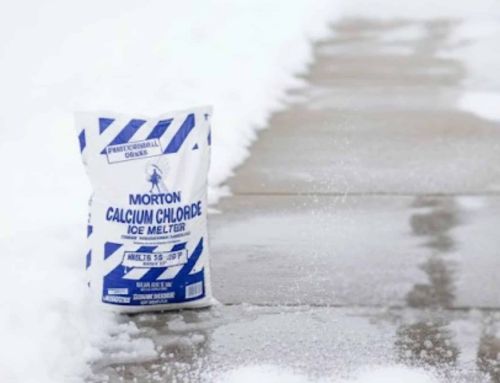Salt is commonly used in winter to keep our roads and driveways safe by melting ice. But have you ever wondered why does salt melt ice? The answer lies in science, particularly in understanding how salt transforms into liquid when it dissolves. Understanding how salt melts ice helps us use it more effectively. It also raises awareness of environmental concerns and alternatives.
In this article, we’ll dive deep into the science behind salt melting ice, explore real-world applications, and discuss the environmental impacts. Whether you’re de-icing your driveway or curious about how salt affects your surroundings, you’ll gain a comprehensive understanding of the process. If you’re looking for a reliable solution for winter maintenance, Old Station Outdoor & Landscape Supply offers sand and salt products designed to make ice melting easy and efficient.
The Science Behind Salt Melting Ice
Salt is widely used during winter to keep roads, driveways, and walkways safe by melting ice. But have you ever wondered how salt actually works to break down ice? The answer lies in the science of freezing point depression, which relates closely to the concept of melting point. When salt is applied to ice, it lowers the temperature at which water freezes, preventing the formation of solid ice and allowing it to melt. In this section, we’ll explore how this process works and why salt is so effective at melting ice.
What Happens When Salt is Applied to Ice?
When you sprinkle salt on ice, something interesting happens. Salt disrupts the normal process of freezing, causing the ice to melt at a lower temperature. This phenomenon is called freezing point depression. Essentially, salt lowers the temperature at which water freezes, preventing the formation of solid ice and allowing the ice to melt.
How Does Freezing Point Depression Work?
Salt works by dissolving into water and separating into sodium and chloride ions. These ions interfere with the ability of water molecules to bond together, which is essential for freezing. As the ice melts, it forms a mixture of water and salt, known as brine. The more salt you add, the lower the freezing point becomes. Sodium chloride (NaCl), or table salt, is the most commonly used salt for melting ice. However, not all salts work the same way. For example, calcium chloride is even more effective at lower temperatures.
Why Does Salt Work Best at Specific Temperatures?
Salt is most effective at melting ice when temperatures are between 15°F and 25°F (-9°C to -4°C). Below these temperatures, salt loses its ability to melt ice efficiently. As the temperature drops further, salt can become less effective, which is why calcium chloride or other alternatives are used for extremely cold conditions.
Real-World Applications of Salt
In regions that experience harsh winters, municipalities rely on salt to keep roads safe. When spread on snow and ice, salt creates a brine layer that prevents further ice from forming. This reduces the risk of vehicles sliding and helps to maintain road traction.
However, the effectiveness of salt depends on the temperature. If it’s too cold, roads may still be slippery despite salt use. In these cases, sand or calcium chloride is sometimes added to help with traction.
Applications of Salt on Roads:
- De-icing: Salt lowers the freezing point to melt snow and ice on roads.
- Prevention: Salt helps prevent the formation of ice by lowering the freezing point.
- Road Safety: Reduces accidents by providing better road grip in winter months.
Other Uses for Salt in Everyday Life
Salt isn’t just used on roads; it has several other applications that help us in everyday life. From food preservation to water softening, salt has a broad range of uses. For example, salt’s ability to absorb moisture is why it’s often used in food packaging.
Salt also plays a vital role in industrial applications like the production of soap, textiles, and paper. In fact, it’s so versatile that scientists and engineers continually seek new ways to use its unique properties in different fields, including applications in aquaculture for fish.
Environmental and Health Concerns
While salt is effective at melting ice, it does have some downsides. One of the major concerns is its environmental impact. Salt runoff can harm plants, animals, and soil quality. When the snow melts, salt can seep into groundwater, affecting local ecosystems and potentially contaminating sources of pure water. Too much salt on the road can lead to damage to vegetation and waterways, especially in areas that receive heavy salt treatment.
For those looking for a more balanced approach to winter maintenance, Old Station Outdoor & Landscape Supply offers high-quality sand and salt mixes that help minimize the environmental impact while still being effective in de-icing.
How Salt Affects Vegetation:
- Salt prevents plants from absorbing water and nutrients.
- Excess salt in the soil can lead to soil salinity, which harms plant growth.
- Salt can contaminate nearby streams and rivers, affecting aquatic life.
How Salt Affects Concrete and Pavement
Salt can also damage your driveway, sidewalks, and roads over time. It can weaken the concrete, leading to cracks and potholes. In addition to physical damage, salt also accelerates the corrosion of metal parts in vehicles, further impacting infrastructure and maintenance costs.
What Are the Health Risks of Overusing Salt in Public Areas?
Salt isn’t just harmful to the environment; it can also be risky for pets and humans. For example, pets can ingest salt while walking outside, leading to salt toxicity. On sidewalks, salt can cause skin irritation for people who walk barefoot. If not managed properly, salt use can become an issue for health, safety, and maintenance.
For an effective, eco-friendly solution, check out Old Station Outdoor & Landscape Supply’s sand and salt product, designed to melt ice while minimizing environmental harm.
Comparing Salt to Other Ice-Melting Materials
A common myth is that sugar can melt ice faster than salt, but that’s not the case. Sugar does lower the freezing point of water slightly, but it’s far less effective than salt. Salt, especially sodium chloride, is more efficient because it dissociates into ions. These ions break the bonds between water molecules, speeding up the melting process.
Comparison of Ice Melting Materials:
| Material | Effectiveness | Temperature Range | Speed of Melting |
|---|---|---|---|
| Salt | Very effective | 15°F to 25°F | Fast |
| Sugar | Less effective | 32°F and below | Slow |
| Calcium Chloride | Highly effective | Below 0°F | Very fast |
Calcium Chloride and Other Alternatives
Calcium chloride is more effective at lower temperatures than salt because it generates more heat when it dissolves in water. It can melt ice at temperatures as low as -25°F (-32°C), making it ideal for extremely cold climates. However, it is more expensive and has a greater environmental impact.
Conclusion
Salt is a simple yet powerful tool for melting ice, thanks to its ability to lower the freezing point of water. However, it’s important to balance its effectiveness with its environmental and health impacts. By understanding how salt works and its cooling effect on ice, we can use it more effectively. Exploring alternatives helps ensure safer and more sustainable winter conditions.
At Old Station Outdoor & Landscape Supply, we offer a high-quality sand and salt mix designed to keep your roads, driveways, and walkways clear of ice and snow throughout the winter months. Our carefully crafted blend ensures effective ice melting even in colder temperatures. This provides you with a reliable solution for winter maintenance. Whether you’re managing a commercial property or maintaining your home’s driveway, our sand and salt mix helps prevent accidents. It also reduces ice buildup and improves traction. Contact us today to learn more about our products and find the perfect winter solution for your needs.
FAQs
Why does salt make ice melt faster?
Salt makes ice melt faster because it lowers the freezing point of water, a process known as freezing point depression. When salt is applied to ice, it causes the ice to melt at a lower temperature than it normally would. This disruption in the ice cubes’ structure speeds up the melting process by preventing the formation of solid ice.
What will melt ice the fastest?
Calcium chloride will melt ice the fastest compared to salt or other substances. It releases more heat when dissolved in water, which accelerates the melting process. Additionally, calcium chloride works effectively at lower temperatures. This makes it ideal for icy conditions.
What does salt actually do to ice?
Salt disrupts the molecular structure of ice by breaking the bonds between water molecules, which prevents the ice from remaining solid. This causes the ice to melt, forming a mixture of salt and water, known as brine. As more salt is added, the freezing point of the water is lowered, allowing more ice to melt.
Why does salt dissolve in water so quickly?
Salt dissolves in water quickly because water molecules are polar, meaning they have a positive and a negative side. These polar water molecules surround the sodium and chloride ions in salt, pulling them apart and facilitating their dissolution. The attraction between water molecules and salt ions accelerates the dissolution process.










